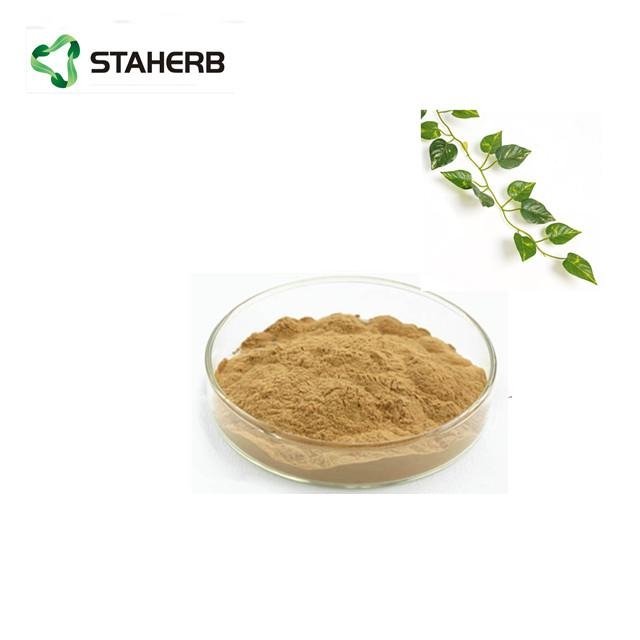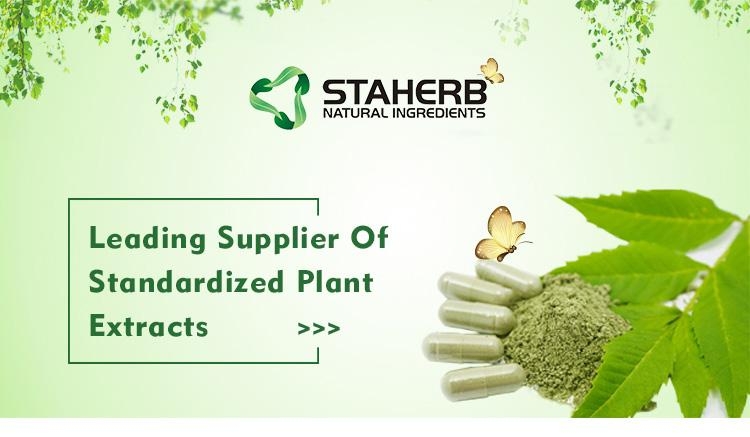
常春藤提取物
品名:常春藤提取物
顏色:棕色粉末
提取部位:全草
級別:製藥級別
檢測方式:HPLC
提取部位: 莖葉
有效成分:常春藤甙C

常春藤提取物是一種從中華常春藤植物的葉中提取的。其主要用途是促進呼吸系統健康,但它還可以用於皮膚抵禦衰老。這種提取物有膠囊和液體形式,可以在很多糖漿劑、軟膏和霜劑中發現它。常春藤(Hedera nepalensis)為五加科常春藤屬植物,主產于陝西、甘肅及黃河流域以南至華南地區。它的同科品種菱葉常春藤與常春藤性能相似,可以互用,都可在化妝品中應用,在此一起介紹。常春藤全年可采,一般秋季采收,切段曬乾。常春藤以全株入藥,它的果實(常春藤子)亦供藥用,化妝品主要採用它們的乾燥莖葉。
常春藤的一些成分有化痰作用。這意味着它有助于減少呼吸系統中積聚的黏液。皂甙和叫做依米丁的生物碱增加肺部黏膜分泌物,在咳嗽時,這些黏液可以通過口腔排出。咳嗽有時會導致支氣管肌肉痙攣,而這種提取物能夠緩解痙攣。
常春藤提取物對哮喘和支氣管炎等特定疾病患者特別有好處。這些疾病的症狀包括呼吸短促,咳嗽,和嚴重喘息等。這與支氣管氣道發炎導致肺部氣流減少有關。這種植物精油能夠幫助促進與肺有關的免疫功能。當黏膜厚度減少時,液體就可以更容易排出。
包含常春藤提取物的乳液或軟膏還有抵禦皺紋的作用。它幫助水合乾燥皮膚,減少面部皮膚細紋。此外,有些包含這種提取物的軟膏還能夠緩解與骨關節炎和風濕病有關的疼痛。這類軟膏有助于加強骨骼,並減少關節炎症。如果皮膚炎症燒傷或損傷,常青藤提取物可以促進細胞再生和癒合。
產品詳詢:13657416805
參考文獻:
- 1.
Akinboye, E. S., Bakare, O. (2011) Biological activities of emetine. Open Nat. Prod. J. 4, 8–15.
- 2.
Baysal, O., Zeller, W. (2004) Extract o. Hedera helix induces resistance on apple rootstock M26 similar to Acibenzolar-S-methyl against fire blight (Erwinia amylovora). Physiol. Mol. Plant P. 65, 305–315.
- 3.
Buchwald, W., Mordalski, R., Kucharski, W. A., Gryszczyńska, A., Adamczak, A. (2015) Effect of fertilization on roseroot (Rhodiola rosea L.) yield and content of active compounds. Acta Sci. Pol. Hortorum Cultus 14, 109–121.
- 4.
Cwientzek, U., Ottillinger, B., Arenberger, P. (2011) Acute bronchitis therapy with ivy leaves extracts in a two-arm study. A double-blind, randomised study vs. another ivy leaves extract. Phytomedicine 18, 1105–1109.
- 5.
Deliorman Orhan, D., Özçelik, B., Hoşbaş, S., Vural, M. (2012) Assessment of antioxidant, antibacterial, antimycobacterial, and antifungal activities of some plants used as folk remedies in Turkey against dermatophytes and yeast-like fungi. Turk. J. Biol. 36, 672–686.
- 6.
Demirci, B., Goppel, M., Demirci, F., Franz, G. (2004) HPLC profiling and quantification of active principles in leaves o. Hedera helix L. Pharmazie 59, 770–774.
- 7.
Dumitriu, B., Olariu, L., Nita, R., Zglimbea, L., Rosoiu, N. (2013) Vascular anti-inflammatory effects of natural compounds fro. Aesculus hippocastanum an. Hedera helix. Rom. Biotech. Lett. 18, 7963–7974.
- 8.
Eguale, T., Tilahun, G., Debella, A., Feleke, A., Makonnen, E. (2007). Haemonchus contortus: In vitro and in vivo anthelmintic activity of aqueous and hydro-alcoholic extracts o. Hedera helix. Exp. Parasitol. 116, 340–345.
- 9.
Elias, R., Diaz Lanza, A. M., Vidal-Ollivier, E., Balansard, G., Faure, R., Babadjamian, A. (1991) Triterpenoid saponins from the leaves o. Hedera helix. J. Nat. Prod. 54, 98–103.
- 10.
Ferrara, L., Naviglio, D., Faralli, S. (2013) Identification of active principles o. Hedera helix L. in aqueous extracts. J. Phytochem. Photon. 114, 170–175.
- 11.
Fodorea, C. S., Vlase, L., Leucuţa, S. E., Tămaş, M. (2005) Phytochemical study on some polyphenols o. Geranium pyrenaicum. Chem. Nat. Compd. 41, 400–403.
- 12.
Gepdiremen, A., Mshvildadze, V., Süleyman, H., Elias, R. (2005) Acute anti-inflammatory activity of four saponins isolated from ivy: Alpha-hederin, hederasaponin-C, hederacolchiside-E and hederacolchiside- F in carrageenan-induced rat paw edema. Phytomedicine 12, 440–444.
- 13.
Gruenwald, J., Brendler, T., Jaenicke, C. (2000). PDR for Herbal Medicines. Medical Economics Company, Montvale.
- 14.
Gülçin, I., Mshvildadze, V., Gepdiremen, A., Elias, R. (2004) Antioxidant activity of saponins isolated from ivy: α-Hederin, hederasaponin-C, hederacolchiside-E and hederacolchiside-F. Planta Med. 70, 561–563.
- 15.
Han, G. R., Wang, Y. F., Feng, S. H., Jia, Y. X. (2013) Simultaneous determination of cephaeline and emetine in ipecac and its preparations using RP-HPLC. Chinese Herb. Med. 5, 286–291.
- 16.
Lutsenko, Y., Bylka, W., Matlawska, I., Darmohray, R. (2010). Hedera helix as a medicinal plant. Herba Pol. 56, 83–96.
- 17.
Mahran, G. H., Hilal, S. H., El-Alfy, T. S. (1975) The isolation and characterization of emetine alkaloid fro. Hedera helix. Planta Med. 27, 127–132.
- 18.
Majester-Savornin, B., Elias, R., Diaz-Lanza, A. M., Balansard, G., Gasquet, M., Delmas, F. (1991) Saponins of the ivy plant. Hedera helix, and their leishmanicidic activity. Planta Med. 57, 260–262.
- 19.
Mandade, R. J., Choudhuri, A., Mashirkar, V., Sakarkar, D. (2010) Analgesic and anti-inflammatory activities o. Hedera helix leaf extract. Pharmacie Globale (Int. J. Comprehen. Pharm.), 1, 1–3.
- 20.
Medeiros, J. R., Medeiros, H., Mascarenhas, C., Davin, L. B., Lewis, N. G. (2002) Bioactive components o. Hedera helix. Arquipél., Life Mar. Sci. 19A, 27–32.
- 21.
Nidiry, E. S. J., Babu, C. S. B. (2005) Antifungal activity of tuberose absolute and some of its constituents. Phytother. Res. 19, 447–449.
- 22.
Pârvu, M., Vlase, L., Fodorpataki, L., Pârvu, O., Roşca-Casian, O., Bartha, C., Barbu-Tudoran, L., Pârvu, A. E. (2013) Chemical composition of celandine (Chelidonium majus L.) extract and its effects o. Botrytis tulipae (Lib.) Lind fungus and the tulip. Not. Bot. Hort. Agrobot. Cluj-Napoca, 41, 414–426.
- 23.
Pârvu, M., Vlase, L., Pârvu, A.-E., Roşca-Casian, O., Gheldiu, A.-M., Pârvu, O. (2015) Phenolic compounds and antifungal activity o. Hedera helix L. (ivy) flowers and fruits. Not. Bot. Hort. Agrobot. Cluj-Napoca 43, 53–58.
- 24.
Peev, C. I., Vlase, L., Antal, D. S., Dehelean, C. A., Szabadai, Z. (2007) Determination of some polyphenolic compounds in buds o. Alnus an. Corylus species by HPLC. Chem. Nat. Compd. 43, 259–262.
- 25.
Rai, A. (2011) The effects of alcoholi. Hedera helix plant extract on Ehrlich ascitic tumour cells in vitro and its antitumour activities in vivo. Int. J. Pharm. Sci. Rev. Res. 11, 47–50.
- 26.
Rai, A. (2013) The antiinflammatory and antiarthritic properties of ethanol extract o. Hedera helix. Indian J. Pharm. Sci. 75, 99–102.
- 27.
Röhner, E., Carabet, A., Buchenauer, H. (2004) Effectiveness of plant extracts o. Paeonia suffruticosa an. Hedera helix against diseases caused b. Phytophthora infestans in tomato an. Pseudoperonospora cubensis in cucumber. J. Plant Dis. Prot. 111, 83–95.
- 28.
Schmidt, M., Thomsen, M., Schmidt, U. (2012) Suitability of ivy extract for the treatment of paediatric cough. Phytother. Res. 26, 1942–1947.
- 29.
Stauss-Crabo, M., Atiye, S. (2009) Ivy, a traditionally used medicinal plant in modern phytotherapy (Review). Z. Phytother. 30, 289–291.
- 30.
Sundaram, U., Gurumoorthi, P. (2012) Validation of HPTLC method for quantitative estimation of L-Dopa fro. Mucuna pruriens. Int. Res. J. Pharm. 3, 300–304.
- 31.
Şesan, T. E., Enache, E., Iacomi, B. M., Oprea, M., Oancea, F., Iacomi, C. (2015) Antifungal activity of some plant extracts agains. Botrytis cinerea Pers. in the blackcurrant crop (Ribes nigrum L.). Acta Sci. Pol., Hortorum Cultus 14, 29–43.
- 32.
Trute, A., Nahrstedt, A. (1997) Identification and quantitative analysis of phenolic compounds from the dry extract o. Hedera helix. Planta Medica 63, 177–179.
- 33.
Uddin, G., Rauf, A., Qaisar, M., Rehman, T. U., Latif, A., Ali, M. (2011) Preliminary phytochemical screening and antimicrobial activity o. Hedera helix L. Middle-East J. Sci. Res. 8, 198–202.
- 34.
Villani, P., Orsière, T., Sari-Minodier, I., Bouvenot, G., Botta, A. (2001) Antimutagenic effects of alphahederin in vitro. Ann. Biol. Clin. 59, 285–289.
- 35.
Vlase, L., Pârvu, M., Pârvu, E. A., Toiu, A. (2013) Chemical constituents of thre. Allium species from Romania. Molecules 18, 114–127.
- 36.
Zafar, I., Mohammad, P., Asadullah Muhammad, I., Bashir, A., Shahida, Z., Saima, G. (2002) Study of the hypoglycemic activity o. Hedera helix L. in alloxan-induced diabetic rabbits. J. Med. Sci. 2, 206–208.
-